#Cooking methods inflammation
Explore tagged Tumblr posts
Text
Foods that fight inflammation
Foods that fight inflammation : A Anti-Inflammatory Adventure: A Personal Journey As a healthy food advocate, I’m always looking to practice what I preach, always on the hunt for the next big story in health and wellness, on my top hit list is fighting inflammation. So, I decided to embark on a personal journey to explore foods that fight inflammation. “Foods that fight inflammation”: Armed with…

View On WordPress
#Anti-inflammatory cooking#Anti-inflammatory diet#Anti-inflammatory foods#Anti-inflammatory meal plan#Apple cider vinegar inflammation#Best foods for inflammation#Cooking methods inflammation#Fermented foods inflammation#Foods that fight inflammation#Foods to reduce inflammation#Ginger for inflammation#Green tea inflammation#Gut health and inflammation#Inflammation reducing foods#Japanese diet for inflammation#Nordic diet benefits#Olive oil anti-inflammatory#Probiotic foods for inflammation#Reduce inflammation
2 notes
·
View notes
Text
Let’s Chat About Eggs and What Barbara O’Neill Has to Say!
Hey there! So, I’ve been hearing some buzz lately about eggs—yep, those little protein-packed wonders we all love—and some surprising advice from Barbara O’Neill. She’s been saying there are certain foods you should never eat with eggs because they could mess with your health. But is she onto something, or is this just another health trend we should take with a grain of salt? I dug into this a…
#Barbara O’Neill#cooking methods#diet#diet tips#Eggs#fitness#food#health#healthy eating#inflammation#nutrient absorption#nutrition
0 notes
Note
Oma. Oma. How dare you let it drop that you make delicious soup every week and not share your methods/recipes? (/lh)
Okay but legit though may we have the Oma soup insights? 🥺🙏 Do you have favortie recipes? Soup bases or methods you'd recommend? Favorite parings of veggies and/or other ingredients that tend to taste good together (i.e. cheddar and broccoli)? Anything else you'd discovered about soup or making soup at you'd like to share? Please <3
LOL I'm so sorry, I didn't realize there were so many soup lovers here!! (As there should be😌😉)
Ah yes, my soup making secrets..

Ok, so Im afraid my methods are kinda chaos😅 I legitimately throw in whatever veggies and protein I have on hand and season with my heart
I also don't eat grains or dairy in my day-to-day (not intolerant, just helps with inflammation) so I don't do a lot of cream based soups. But here's some things I've found!
Red Boat fish Sauce has a really good umami flavor that you can add to your broths! Doesn't taste fishy AT ALL.
if you've already salted your food but it still tastes like you could use salt, try adding lemon or lime juice. It adds SO much that salt can't.
Potato starch is a great non-flour/gluten way to thinken your soup base! Just don't forget to make a slurry so it doesn't clump
Coconut cream or soaked,blended cashews can be a really good dairy substitute. The flavor isn't really the same, but it adds a creaminess that dairy does.
Don't underestimate the power of bouillon cubes. Oh and I use the chicken juices that come out during the cooking process as broth for extra flavor.
Immersion blenders (or blenders in general) are GREAT if you want a creamy soup but don't want dairy or flour to thicken it. I like to blend squash and potatoes for those kinds of soups
And now, a tier of my favorite soups:
My mom's chicken noodle soup (hers specifically)
Sausage and sauerkraut soup
Whole 30 Chicken Pot Pie soup
Chili
I often use Pinterest as a guide if I want to use specific ingredients (I made a spring onion soup once cus I was given like, 15 bundles of them)
Often tho i just make different variations of vegetable soup and throw in some chicken. It's nothing life changing but it usually tastes pretty good haha
What are your favorite soups?? You have your own tips and tricks???!
#i hope this helps in your soupy endeavors!#sweet kittyburger#i wish I was more sofisticated in the way I cook#but unfortunately I cook like a stay at home mom with 6 children lol#i also give myself a VERY strict montly food budget#so I often make the same types of soups cus I buy the same groceries every month haha#minus some seasonal stuff
24 notes
·
View notes
Text

The Healthiest and Unhealthiest Seafood Dishes You Need to Know!
Choosing seafood dishes can be tricky. This guide helps you pick the best and avoid the worst. Find out which dishes are full of omega-3s and which might add too much sodium or additives.
Whether you're cooking at home or eating out, we explain what makes some seafood healthy and others not so much. See how cooking and ingredients can turn a healthy meal into a calorie-heavy one.
delight, perfectly aligning with the article's subject and section title.
Key Takeaways
Best seafood options like grilled salmon provide heart-healthy omega-3s.
Worst seafood choices often include fried or battered varieties.
Unhealthy seafood can hide sodium or additives, reducing nutritional value.
Cooking methods like baking or steaming boost health benefits over frying.
Prioritizing low-mercury, wild-caught options keep meals nutritious and safe.
Why Your Seafood Choices Matter for Health
Choosing the right seafood is more than just about taste. It affects your health and the planet. Let's explore how seafood nutrition and ethical sourcing impact your well-being.
Nutritional Profile of Seafood
Seafood is full of essential nutrients. Fatty fish like salmon and mackerel are rich in omega-3 fatty acids. These acids are good for your heart and brain. Whitefish and shellfish offer lean protein, while oysters and clams are good sources of zinc and iron.
Omega-3s reduce inflammation linked to chronic diseases
Vitamins D and B12 support immunity and energy
Low in saturated fats compared to red meat
How Seafood Fits Into a Balanced Diet
Adding seafood to your meals can meet dietary guidelines. Aim for 2-3 servings a week. This can replace higher-fat proteins. Here's a quick guide:
Type
Omega-3 (mg/serving)
Protein (g)
Salmon
2,260
22g
Shrimp
230
24g
Sardines
1,400
21g
Pair seafood with veggies and whole grains for a balanced meal. Look for sustainable seafood labels to support health and ethics.
Environmental and Ethical Considerations
Choosing sustainable seafood helps ocean ecosystems thrive. Overfished species like bluefin tuna harm marine life. Look for MSC (Marine Stewardship Council) and ASC (Aquaculture Stewardship Council) labels for responsibly sourced seafood. Sustainable choices align seafood in diet with health and environmental goals.
The Nutritional Powerhouses: Top Healthy Seafood Dishes
Some seafood dishes are packed with nutrients. They offer great health benefits without extra calories or additives. These nutritious fish dishes are perfect for those who want to eat healthy.
Grilled wild salmon with herbs: This dish is full of omega-3 rich seafood. It has anti-inflammatory benefits and vitamin D. Cooking on a cedar plank adds flavor without oil.
Steamed mussels in broth: A low-calorie seafood choice, it's rich in lean protein and iron. Try it with garlic-lemon broth for extra vitamin C.
Baked cod with lemon-dill: This white fish is low in calories but high in protein. Season it with citrus and herbs instead of butter.
Tuna poke bowls: Sashimi-grade ahi tuna is a great source of omega-3s. Add edamame, avocado, and seaweed salad for extra fiber and minerals.

"These dishes show how seafood can be both healthy and tasty," says registered dietitian Dr. Emily Carter. "Using whole foods and simple cooking methods boosts their health benefits."
It's important to control portion sizes. Aim for 4-6 oz servings to keep protein balanced. Add sides like roasted veggies or quinoa for a complete meal. Avoid breading or creamy sauces to keep dishes light and tasty. These tips make it easy to enjoy seafood's health benefits without losing flavor.
Wild-Caught vs. Farm-Raised: Understanding the Difference
Your seafood choices affect your health and the planet. Let's explore the differences between wild-caught fish and farm-raised seafood. This will help you make better choices.
Nutritional Variations Between Wild and Farmed Fish
Wild-caught fish are often leaner and have more omega-3s because of their natural diet. Farm-raised seafood, raised in controlled environments, might have more fats from processed feeds. For instance, wild salmon has more protein per serving than farmed salmon.
However, some farms now use sustainable feeds to close this nutritional gap.
Environmental Impact Considerations
Wild-caught fishing can harm delicate species. Sustainable fishing methods protect ecosystems, but not all follow these practices. Farm-raised seafood can reduce pressure on wild stocks but may pollute waters.
Look for certifications like ASC or BAP to ensure aquaculture meets eco-standards.
Taste and Texture Differences
Wild-caught fish have firmer flesh and unique flavors from their ocean diets. Farm-raised options are softer and milder. Shrimp from farms might taste sweeter, while wild-caught shrimp have a brinier taste.
Texture differences are important in dishes like sushi or soups, where mouthfeel matters.
Both wild-caught and farm-raised seafood have their advantages and disadvantages. Choose sustainable fishing practices for wild options. For farm-raised, look for certified brands that balance nutrition and ethics.
Popular Seafood Dishes Ranked by Health Benefits
Start by looking at this seafood nutritional ranking. Choose dishes that are good for you and not too risky.

Omega-3 Rich Options
At the top, are the best fish for omega-3 like salmon (2.3g per 3-oz serving) and mackerel (1.8g). Choose baked or grilled to keep nutrients in. Sardines and herring are also good, perfect for salads or snacks.
Salmon: 2,200 mg omega-3 per serving
Mackerel: 1,800 mg
Sardines: 1,400 mg
Low-Mercury Selections
For eating often, pick low-mercury seafood like shrimp, scallops, and clams. Tilapia and catfish are also safe, with mercury under 0.1 ppm. They're great in soups or stir-fries.SeafoodMercury (ppm)Shrimp0.023Scallops0.021Clams0.012
Protein-Packed Choices
Look for high-protein seafood like grilled tuna (26g protein/serving) or shrimp stir-fry (23g). Ceviche and seafood stews also have 20-25g protein. They keep you full and give you energy.
Remember, how it's cooked matters. Grilling or steaming keeps nutrients better than frying. This guide helps you enjoy tasty food that's also good for you.
Red Flags: The Unhealthiest Seafood Preparations to Avoid
Choosing the right seafood means knowing what to steer clear of. Unhealthy seafood dishes often masquerade as favorites, but their downsides are significant. Fried fish, like battered cod or crispy shrimp baskets, is a big no-no. These dishes load up on empty calories and trans fats, losing the omega-3 benefits.
Fried Fish: Breading and deep frying increase calorie counts. Choose grilled or baked options instead.
Cream-Based Soups: New England clam chowder or seafood alfredo are high in saturated fats and sodium.
Smoked and Canned Options: Smoked salmon or canned tuna in oil are high in sodium. They're seafood to avoid for those watching sodium.
“The breading in fried seafood isn’t just crispy—it’s a calorie trap. Opt for blackened or roasted alternatives to keep nutrients intact.”
Restaurant high-sodium seafood dishes can have over 1,500mg sodium in one serving—almost the daily limit. Always check labels on prepackaged items and ask about cooking methods when eating out. Swapping creamy sauces for lemon or herbs reduces calories without sacrificing taste. Being aware is crucial: these seafood to avoid can still be enjoyed in moderation with careful choices.
How Cooking Methods Transform Your Seafood's Health Profile
Choosing the right way to cook fish and seafood can make them healthier. Cooking seafood healthily means keeping nutrients like omega-3s and vitamins. Let’s look at how different cooking methods affect nutrient preservation and flavor.

Healthiest Cooking Techniques
Steaming: Keeps moisture and nutrients in. Great for delicate fish like cod or sole.
Grilling: Use a grill basket to keep healthy oils in. Marinate with olive oil and herbs for extra taste.
Baking: Season with lemon and dill. Try salmon baked at 375°F for 15-20 minutes.
Poaching: Simmer in broth or white wine. This method adds nutrients without extra fats.
Methods to Avoid
Some cooking methods add too many calories:
Frying in oil: Adds over 100 calories per serving.
Cream-based sauces: Increase fat content by double.
Breading or deep-frying: Adds more calories than baking.
Preserving Nutrients During Cooking
Here are tips to keep nutrients in your food:
Cook at lower temps (below 375°F) to prevent omega-3 breakdown.
Use acidic ingredients like lime juice (as in ceviche) to protect vitamin C.
Reuse cooking liquids (broth or water) in soups to capture soluble vitamins.
MethodNutrient RetentionCalories AddedSteaming95%0-50Grilling85%20-70Frying50%200+
Hidden Dangers: Additives and Ingredients in Prepared Seafood Dishes
Seafood additives and hidden ingredients in fish can turn a healthy meal into a source of unwanted chemicals. Many processed seafood products use preservatives to extend shelf life or improve appearance. These choices matter for your health.
Sodium phosphates in fish fillets to retain moisture, which may strain kidney function.
Nitrites in smoked seafood that could form harmful compounds during cooking.
Artificial colors like red 3 in imitation crab, linked to allergic reactions.
AdditivePurposeHealth RisksAlternativeSodium PhosphatesMoisture retentionElectrolyte imbalanceFresh fish without additivesHigh-Fructose Corn SyrupSweetness in saucesAdded sugarsLow-sugar dipping sauces
Processed seafood risks also come from breading filled with refined carbs and hydrogenated oils in frying. Check labels for terms like "modified starch" or "partially hydrogenated oils"—these signal hidden ingredients in fish dishes. When dining out, ask servers about marinades or coatings. Opt for grilled or broiled options to avoid seafood preservatives. A simple rule: fewer ingredients on the label often mean better choices.
Stay informed to protect your health. Always read packaging and ask questions when eating out. Small steps like this help you enjoy seafood’s benefits without the hidden risks.
Seafood Dishes From Around the World: Health Heroes and Villains
Seafood traditions from around the globe bring us tasty and nutritious dishes. Let's dive into how Mediterranean, Asian, and American seafood balance flavor and health. This way, we can make better choices.
Mediterranean Seafood Traditions
Mediterranean fish dishes are all about fresh ingredients and simple flavors. Grilled octopus with olive oil and lemon is a great source of omega-3s. Spain's paella and Italy's acqua pazza also stand out for their use of herbs and light broths.
These methods help keep nutrients in the food. They support heart-healthy diets.
Asian Seafood Preparations
Healthy Asian seafood is known for its light and fresh flavors. Japanese sashimi and Vietnamese pho are great examples. They use raw fish or light broths.
But, avoid dishes with tempura batter or sugary sauces. They add empty calories. Korean kimchi stews are a good choice for flavor without too much oil.
American Seafood Favorites
American seafood culture includes classics like New England boils and Louisiana gumbo. Shrimp and corn in boils are healthy. But, fried catfish or dishes with cheese add unhealthy fats.
Opt for broiled or blackened seafood instead. They offer a protein boost without extra grease.
Enjoying Mediterranean fish dishes or healthy Asian seafood is a great way to explore global flavors. Focus on herbs, citrus, and broths. This supports international seafood health goals.
Special Dietary Concerns: Seafood for Different Health Needs
For those with seafood allergies, picking the right seafood is key. Always check for cross-reactivity risks. Opt for well-cooked dishes to reduce allergen exposure. Pregnant individuals should choose low-mercury seafood like salmon or cod. These provide omega-3s important for fetal brain development without risks.
Supporting seafood for heart health means choosing fatty fish like mackerel or sardines. Their omega-3s help lower triglycerides and reduce heart disease risks. For low-cholesterol seafood options, lean choices like cod, haddock, or shrimp are great. They fit well into heart-healthy diets when prepared without added fats.
“Omega-3 rich seafood supports cardiovascular function and prenatal development when chosen wisely.”
Heart health: Prioritize mackerel, sardines, and trout.
Pregnancy: Avoid swordfish and shark; favor salmon and pollock.
Allergies: Stick to thoroughly cooked options and consult allergists before trying new species.
Cholesterol management: Opt for baked or grilled cod, herring, or clams.
Consult healthcare providers for personalized advice. Small changes, like swapping fried calamari for grilled shrimp, can make meals safe and nourishing. Always read labels and ask about preparation methods to align choices with health goals.
Making Smart Choices: How to Order Seafood at Restaurants
Enjoying seafood at restaurants doesn’t mean you have to give up on health. Follow these steps to make smart ordering healthy seafood choices. Choose better restaurant seafood options every time.
Questions to Ask Your Server
Empower your choices with these simple questions:
“How is this fish prepared?” (Grilled or baked beats fried)
“Is this wild-caught or farm-raised?”
“Can you prepare it without added butter or salt?”
Menu Red Flags
Watch for terms like:
Crispy (fried or breaded)
Creamy (often high in saturated fats)
Au gratin (cheese-laden sauces)
These dishes often add 300+ extra calories. Opt for items labeled “grilled” or “poached” instead.
Healthier Substitutions to Request
Ask for these swaps to upgrade your meal:
Swap fries for steamed veggies or a side salad
Request sauces on the side
Choose shrimp or scallops over battered fish
At fast-casual spots, prioritize grilled salmon bowls. Even in fine dining, ask chefs to omit breading or use olive oil instead of butter.
“The menu is your roadmap—ask questions and make swaps to keep dishes light and nutritious.”
Conclusion: Balancing Enjoyment and Health in Your Seafood Choices
A balanced seafood diet doesn't mean you have to choose between taste and health. Opt for dishes like grilled mackerel or baked cod. They're full of omega-3s and are light on the preparation side. This way, you fuel your body and help the planet.
It's okay to treat yourself to dishes like crispy fish tacos or creamy bisque. Just make sure to add veggies or whole grains to keep things balanced. Asking chefs about where their seafood comes from and how it's prepared is a good start. Making small changes, like choosing broiled over fried, can make a big difference over time.
Trying new recipes or enjoying sashimi-grade tuna at a trusted sushi spot can make your choices exciting. Remember, it's about progress, not perfection. Whether you're grilling at home or dining out, make informed choices. Enjoy every bite, knowing you're taking care of your health and the oceans.
https://www.homehealthyremedy.com
FAQ
What are the healthiest types of seafood to include in my diet?
Wild-caught salmon, mackerel, sardines, and trout are top choices. They're packed with omega-3s, protein, and vitamins.
How can I tell if seafood is fresh when shopping?
Fresh seafood smells like the ocean and feels firm. Its eyes should be clear, and the skin shiny. Check the sell-by date too.
Are farm-raised seafood options healthy?
Yes, if they come from responsible farms. Look for options without harmful additives for the best health benefits.
What are some common unhealthy seafood preparations to avoid?
Steer clear of deep-fried dishes like fish and chips. They're high in unhealthy fats. Also, avoid creamy sauces and high-sodium foods like smoked fish.
How can I enjoy seafood in a healthier way at restaurants?
Choose grilled, baked, or steamed seafood. Ask about how it's prepared and request sauces on the side. Opt for dishes with fresh ingredients and minimal additives.
What seafood should I avoid during pregnancy?
Pregnant women should skip high-mercury fish like swordfish and king mackerel. Instead, go for shrimp, salmon, and tilapia. Just remember to eat in moderation.
How do cooking methods impact the healthiness of seafood dishes?
Steaming, grilling, and baking keep seafood nutritious. But deep-frying and rich sauces add unhealthy fats. Choose low-oil methods for the healthiest dishes.
Are there any hidden ingredients I should watch out for in prepared seafood dishes?
Yes! Watch for high-fructose corn syrup, sodium phosphates, and hydrogenated oils. Always read labels to avoid unwanted additives.
What are some key benefits of including seafood in my diet?
Seafood is great for your heart, brain, and joints. It's full of omega-3s, protein, and vitamins D and B12. Eating it regularly can boost your overall health.
2 notes
·
View notes
Text
Pure Groundnut Oil: Beneficial or Cretinous for Cooking? - Jivika

There are so many cooking oils on the market; however, pure groundnut oil stands strong as a testament to traditional wisdom and modern nutritional science. The experts at Jivika Industries Pvt Ltd understand that choosing the right cooking oil is very important in an age where purity is always questioned. Although not many people think so, your decision can significantly impact your family’s health and well-being, which nobody wants to take a bet on.
Groundnut oil, also known as peanut oil, is widely used in most cultures for cooking. You probably know that when most oils are processed, they lose their nutrients, but groundnut oil retains its vitamin E, which is a powerful antioxidant and cell protector. It also has resveratrol, which helps reduce inflammation, making it a healthy choice for cooking.
We are happy to say that Jivika Oil, especially our Ghani groundnut oil, gives health-conscious individuals a great mix of healthy fats. These fats meet the World Health Organization's daily fat intake recommendations. So, one can vouch that Jivika stands out by maintaining the natural goodness of groundnuts through our traditional extraction methods.
Pure groundnut oil consists of unsaturated fats that are heart-friendly, unlike some saturated fats that elevate cholesterol. We retain the inherent characteristics of our oil, thereby making it ideal for deep frying and normal cooking owing to its high smoke point.
For a healthy daily fat intake of 15% to 30% suggested by health experts, Jivika Oil gives you a reliable solution. Our Ghani groundnut oil strikes the right balance of flavour and health benefits, making it a great choice for all the health-focused families.
So why wait to switch to Jivika? Choose Jivika for a healthier tomorrow.

#jivika oil#jivika#jivika group#jivika pure groundnut oil#groundnut oil#ghani groundnut oil#kachi ghani groundnut oil#jivika oil price#jivika groundnut oil price#groundnut oil price#best groundnut oil 1 litre#groundnut oil 5 litre#groundnut oil 15 litre#groundnut oil exporters
2 notes
·
View notes
Text
White, brown or red? A guide to choosing the healthiest rice for your meals
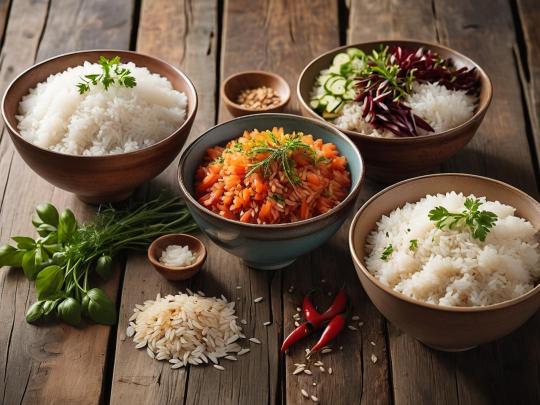
Rice is a staple food for millions of people around the world, providing a versatile and comforting base for countless dishes. With so many varieties available, choosing the healthiest rice for your meals can be overwhelming. Whether you're looking for a quick side dish, a hearty main course, or a gluten-free option, understanding the nutritional benefits and culinary uses of white, brown and red rice can help you make the best choice for your diet and lifestyle.
In this guide you'll explore the unique properties of each rice type, providing valuable information about their health benefits, nutritional profiles and ideal cooking methods. In the end, you'll be armed with the knowledge to choose the right rice for your meals, enhancing both your health and culinary experience.
Nutritional Comparison: White, Brown and Red Rice
When it comes to nutritional content, not all rice is the same. Each variety offers different benefits that meet different dietary needs and preferences.
White rice: Often considered the most popular, white rice is milled and polished, removing the bran and germ. This process results in a softer texture and longer shelf life but also reduces its nutritional content. White rice is typically enriched with iron and B vitamins, making it a robust choice. However, it has a higher glycemic index (GI) than other varieties, which can more significantly impact blood sugar levels.
Brown rice: A whole grain, brown rice retains its bran and germ, preserving essential nutrients such as fiber, magnesium, and phosphorus. Its high fiber content aids digestion and may contribute to heart health by lowering cholesterol levels. Brown rice has a lower GI than white rice, making it a more suitable choice for those managing blood sugar levels.
Red rice: Known for its distinctive color and nutty flavor, red rice is rich in anthocyanins, powerful antioxidants that give it its red color. These antioxidants are believed to reduce inflammation and support heart health. Red rice is also rich in fiber, iron, and other essential nutrients, making it a nutrient-rich option for any meal.
Health Benefits and Considerations
Benefits of white rice: Although often overshadowed by its nutrient-rich counterparts, white rice remains a good choice for those with digestive sensitivities. Its mild flavor and soft texture make it easily digestible, and it is often packed with essential nutrients. Additionally, white rice is a quick-cooking grain, ideal for busy weeknights.
Benefits of brown rice: The fiber in brown rice can aid digestion and promote a feeling of fullness, which can be beneficial for weight management. Its low GI also makes it a better choice for individuals with diabetes or those looking to stabilize blood sugar levels. The nutrient profile of brown rice supports heart health and provides sustained energy.
Benefits of Red Rice: The high antioxidant content in red rice provides unique health benefits, including anti-inflammatory properties and potential protection against chronic diseases. Its robust flavor pairs well with a variety of dishes, making it a versatile addition to your pantry. The iron content in red rice may also be a valuable nutrient for those at risk for anemia.
Choosing the Right Rice for Your Dietary Needs
Choosing the right rice depends on your dietary preferences and health goals. For those following a gluten-free diet, all three types of rice are safe choices. If you are focused on weight management or blood sugar control, brown or red rice may be more suitable due to its low GI and high fiber content. For athletes or individuals who need an instant energy boost, white rice may be a practical option.
Also consider the type of food you're preparing. The neutral flavor of white rice pairs well with a wide range of dishes, from stir-fries to desserts. The chewy texture and nutty taste of brown rice is perfect for grain bowls and salads, while the rich flavor of red rice can enhance soups, stews, and hearty main dishes.
You can also order large quantities of healthy Basmati rice from Vi Exports India.
2 notes
·
View notes
Text
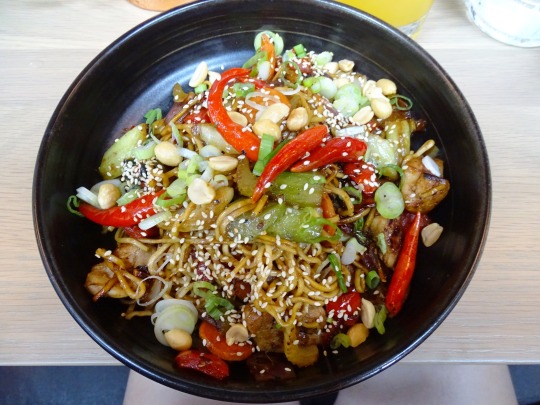









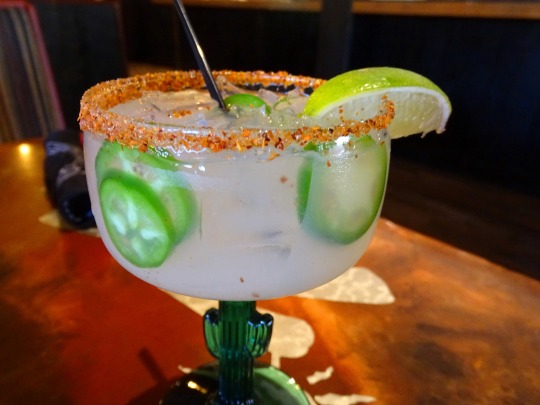
















National Hot Heads Chili Day
Chili lovers celebrate National Hot Heads Chili Day on January 17 every year. On this day, chili heads, heat-seekers, and extreme eaters try out the spiciest chilis. National Hot Heads Chili Day is celebrated with habanero-eating challenges, fancy-dress contests, and cook-offs of popular recipes. Chilis are also made to take the official Scoville heat scale. This doesn’t mean that you have to be a daredevil to celebrate the day — anyone who likes their meal a little hot can celebrate the day! Spices and chilis add a distinct flavor to the dish. Thai, Indian, Creole and Caribbean dishes are famous for their heat content and boast of some excellent gastronomic experiences!
History of National Hot Heads Chili Day
We don’t quite know how National Hot Heads Chili Day came to be but it’s safe to say that one fine day all the chili lovers got together and decided to celebrate hot and spicy food. This makes sense given how humans have always had a knack for chilis in their food — the first recipes for spicy foods go back to 6,000 years! This means that humans have been enjoying spicy food for quite some time. While the foods that we enjoy today may have changed and recipes altered, we still love spicy food. Unlike other animals, humans prefer spicy food simply because it tastes so incredible and on a plus side, spices also offer several health benefits.
Spices such as turmeric and cumin that have powerful antimicrobial and antioxidant properties can kill bacteria outright. Studies show that the capsaicin in hot peppers can reduce inflammation and decrease the chances of heart disease. It can also aid in weight loss. In Ayurvedic medicine, the inflammatory properties of chilis have brought relief from many different conditions, such as headaches, autoimmune disorders, and arthritis. Spicy foods can also help fasten your metabolism. Studies also show that certain spices, like pepper chilies, turmeric, cinnamon, and cumin can curb your appetite and improve your metabolic resting rate. Who knew chilis could be so versatile!
National Hot Heads Chili Day timeline
3500 B.C.
Chilis Are Cultivated
Chilis are grown and cultivated for the first time.
1498
Chilis Arrive In India
Vasco-da-Gama reaches Indian shores and introduces India to chilis.
1912
Scoville Organoleptic Test
Wilbur L. Scoville finds a new method to measure the pungency of chilis.
1975
Chili’s
Larry Lavine opens the first Chili's in Dallas.
National Hot Heads Chili Day FAQs
Are chillies native to India?
After the Portuguese arrival in India, chilies were first introduced to Goa, from where they spread to South India. Today, India is the largest producer of red dried chili in the world.
Which chili is the spiciest?
A Guinness Book record holder, Bhut Jolokia is certified as the hottest chili in the world. It is also known as ‘ghost pepper’ and is cultivated in Arunachal Pradesh, Assam, Nagaland, and Manipur.
Which chili is the healthiest?
Green chilies have high water content and zero calories which makes them a healthy choice for those who are trying to shed some pounds.
National Hot Heads Chili Day Activities
Host a dinner party: Chilis are regularly used in Indian, Chinese, and Thai cooking. Host a dinner party and serve these cuisines to friends and family.
Learn about different chilis from around the world: On National Hot Heads Chili Day, learn more about the different chilies that are available around the world. There are so many different types, including Carolina Reapers, Ghost Peppers, Habanero, Red Cayenne Pepper, Serrano, Guajillo, Poblano, Peppadew, and much more.
Organize a cook-off: Invite your friends over and see who can create the best hot and spicy dish. Flavor your dishes with different types of chilis and find out which one is the hottest.
5 Facts About Chilis That Will Blow Your Mind
Chilis can make you happy: They help release feel-good endorphins and dopamine, which results in a sense of euphoria.
The Japanese had an innovative use: Instead of eating them, the Japanese put them in their socks to keep their toes warm.
They are rich in nutrients: They contain large amounts of vitamin C, provitamin A, and beta-carotene.
Only mammals are sensitive to chilis: Capsaicin may burn and irritate the flesh of mammals but birds are completely immune to its effects
They can be used as first aid: Cayenne pepper can help stop bleeding.
Why We Love National Hot Heads Chili Day
A day to enjoy your favorite foods: Most of us love spicy foods but it’s not possible to savor them every day. National Hot Heads Chili Day offers the perfect opportunity to indulge in your favorite spicy food.
Try a new cuisine: If you don't have an adventurous palate, today is the best day to rectify that. Sample spicy foods from India, Thailand, the Philippines, and the Caribbean.
A day to be adventurous: If you are an adventurous foodie, then National Hot Heads Chili Day invites you to taste some of the hottest and steamiest chilies from the world over. Go on a gastronomic adventure today!
Source
#Green Chile Cheeseburger#Chili Cheese Fries#Chili Burger#Green Chili Stew#Chicken Hunan Kung Pao#Eric's Burger#Passionfruit Chili Margarita#National Hot Heads Chili Day#travel#original photography#vacation#USA#Canada#Sweden#restaurant#street food#NationalHotHeadsChiliDay#17 January
5 notes
·
View notes
Text
Health Importance of Black Rice
Introduction
Black rice is also known as forbidden rice or purple rice, primarily cultivated in the northeastern states of India, with Manipur being a significant producer. its is a G.I Tag Crop of Manipur and here it is known as “Chak-Hao”, this rice that has gained attention in recent years due to its unique color, distinct flavor, and impressive nutritional profile. Historically, it was once considered a rare and precious grain reserved for royalty in ancient China. The nutritional value of black rice (100 g, cooked rice)
· Calories: 150 kcal · Carbohydrates: 34 g · Protein: 3 g · Fat: 1.5 g · Fiber: 2 g · Vitamin E: 0.8 mg · Iron: 1.5 mg · Magnesium: 43 mg · Phosphorus: 101 mg · Potassium: 84 mg · Zinc: 1.2 mg Black rice is also a good source of various vitamins and minerals, as well as dietary fiber & a powerful antioxidant, Anthocyanin. These values are approximate & can vary slightly depending on factors such as the variety, growing conditions, and processing methods. Health Benefits of Black Rice:
1. Rich in Antioxidants, as anthocyanins, reducing oxidative stress and inflammation 2. Improved Heart Health by reducing cholesterol levels, improving blood vessel function, and regulating blood pressure. 3. Improved Digestion by its high fiber content which aids in digestion and can help prevent constipation. 4. Blood Sugar Regulation, due to the slow digestibility of black rice, beneficial in diabetes. 5. Cancer Prevention, anthocyanins have potential anti-cancer properties and may help inhibit the growth of cancer cells 6. Weight Management due to high fiber & slow digestion 7. Nutrient rich food, maintain overall health & improve immune system 8. Allergen-Free, free from gluten sensitivity or celiac disease. 9. Neuroprotective effect improve Brain Health
Black rice has a slightly nutty flavour & chewy texture. It requires longer cooking time and more water than white rice due to its bran layer. It can be used in both sweet and savoury dishes. In Asian cuisines, black rice is often used in traditional desserts, rice-based puddings, and porridge. It can also be incorporated into salads, side dishes, and even main courses for a visually striking and nutrient-rich meal
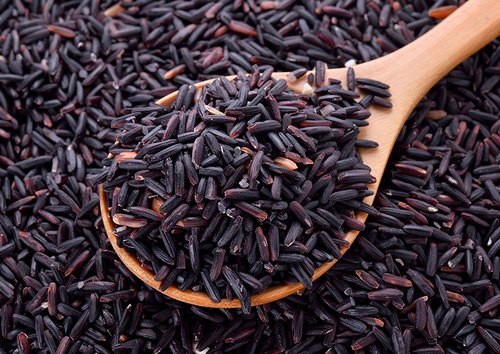
2 notes
·
View notes
Text
fiddlehead health benefits
Fiddlehead Ferns: Nutritional Powerhouse of a Super Food to Add to Your Diet

Introduction
When it comes to wild edibles, few plants spark curiosity — and the taste buds — like fiddlehead ferns.
Fiddleheads are growing in popularity now that more people are looking for organic, foraged, nutrient-dense foods.
Their notable health benefits
How to prepare and cook them in a safe way
Delicious recipe ideas
I would like to learn search engine optimization to promote this blog and our website. How can I do this?
Where Do They Grow?
Discovered in North America, Europe, and Asia
Grow in damp, shady woods, along river banks
Collected in early spring (April–May).
Flavor Profile
✔ Asparagus (earthly, grassy)
✔ Spinach (slightly bitter)
✔ Green beans (crisp texture)
The Top 7 Health Benefits of Fiddleheads
Packed with Antioxidants
Spirals of ferns are filled with vitamin A, vitamin C, and polyphenols, which promote:
Scavenge free radicals (decrease oxidation stress)
Reduction of inflammation (associated with chronic diseases)
Maintain the health of the skin (prevent early aging)
Energy & Blood Health – High in Iron
✔ Prevents anemia (fatigue and weakness)
✔ Aids in oxygen transport in the blood
Great Source of Omega Fatty Acids
Boost brain function
Reduce heart disease risk
Fight inflammation
Keeps You Going with Fiber
✔ Balance gut microbiome
✔ Prevent constipation
✔ Help with weight management (stave off hunger)
Rich in Potassium, good for the Heart
Potassium helps:
Regulate blood pressure
Balance electrolytes
Reduce stroke risk
Boost Immunity: With Vitamin C
One cup of the fruit provides ~44 percent of the average daily requirement of Vitamin C, which:
✔ Strengthens immune defense
✔ Stimulates the production of collagen (skin & joints).
May Help Detoxify
There is some evidence that fiddleheads aid the liver in detoxification, allowing your body to expel toxins.
How to Safely Clean & Cook Fiddleheads
⚠️ Warning: Some raw or undercooked fiddleheads may have menstrual-toxin-mild toxins (say, some shikimic acid) that can make you a bit sick to your stomach. Always cook them properly!
Step-by-Step Prep Guide
RINSE WELL – Get rid of all the dirt and the brown husks.
Blanch or boil – Boil in boiling water for 10- 15 minutes.
Popular Cooking Methods
Fiddleheads sautéed (butter, garlic)
Stir-fried fiddleheads (with soy and ginger)
Pickled fiddleheads (for canning)
Soup made of fiddleheads (cream or broth)
3 Scrumptious Fiddlehead Recipes to Try
Garlic Butter Sautéed Fiddleheads
Ingredients:
2 c fiddleheads (cleaned & boiled)
2 tbsp butter
3 garlic cloves (minced)
Salt & pepper to taste
Instructions:
Heat butter in a pan.
Stir in garlic and sauté until aromatic.
Add fiddleheads and cook for 5-7 minutes.
Season and serve!
Fiddlehead & Mushroom Risotto
A perfect dish for spring: Silky and earthy all at once.
Salad of Fiddlehead Ferns with Lemon Vinaigrette
A fresh, healthy side.
Tips on SEO Optimization for an Extended Reach
To make sure that this blog makes a serious play in Google search results and draws some readers, use the following SEO best practices:
Keyword Targeting
Primary Keywords:
"Fiddlehead health benefits"
"How to cook fiddleheads"
Are fiddleheads edible?
Long-Tail Keywords:
"Best way to cook fiddlehead ferns"-
“Simple fiddlehead recipes for the novice”
Engaging Meta Description
"Learn about the amazing health benefits of fiddlehead ferns, how to cook them safely, and yummy recipes! Foraged food enthusiasts won’t be able to read it fast enough.
Internal & External Linking
Link to related posts (for instance, "Wild Edibles You Can Forage")
Cite reputable sources (USDA, health articles)
High-Quality Visuals
Use tasty pictures of cooked fiddleheads
Use infographics for nutrition information
Encourage Engagement
End with a call to action: “Have you ever tried fiddleheads?
Final Thoughts
Fiddleheads are not just a seasonal novelty: They’re a superfood, with immune-boosting, heart-healthy detoxifying properties. It turns out you can also eat them (safely!).
0 notes
Text
Is the Cow Ghee 1kg Price Worth It? Health Benefits Explained
Cow ghee has long been a staple in Indian kitchens and Ayurvedic wellness traditions. With rising health awareness and increasing demand for pure, chemical-free alternatives, many people are now closely evaluating the cow ghee 1kg price and wondering if it's worth paying a premium. On this page, we’ll explore the real value behind the cost, break down the health benefits, and explain why quality matters more than quantity when it comes to ghee.
Understanding the Real Value of Cow Ghee
Ghee is not just a cooking fat—it's a traditional superfood. When you buy a 1kg pack of cow ghee, you’re not simply investing in a kitchen essential; you're buying a nutritional powerhouse. Many ask whether the cow ghee 1kg price is justified, especially when they see cheaper alternatives on supermarket shelves. The answer lies in the method of preparation, the source of milk, and the brand’s authenticity.
Brands like DCGhee produce ghee from A2 cow milk using the traditional bilona method. This results in pure, aromatic, and nutrient-rich ghee. Such preparation requires time, care, and resources, which explains why the pure desi ghee price 1kg is higher compared to mass-produced ghee.
What Affects the Cow Ghee 1kg Price?
Several factors influence the price of 1kg cow ghee. The breed of cow, its diet, and the ghee-making process all play a role. For example, A2 cow milk (derived from indigenous cows like Gir or Sahiwal) is costlier to obtain than standard dairy milk. Additionally, when ghee is prepared using traditional slow-churning techniques, the yield is low, but the quality is exceptional.
This explains the variation in desi ghee 1 kg price across different brands. DCGhee focuses on delivering authenticity, which naturally reflects in their pricing. It’s important to note that cheaper ghee options may include additives, artificial flavoring, or low-quality fats that offer little to no nutritional value.
The Health Benefits That Justify the Price
One of the primary reasons people switch to cow ghee is for its numerous health benefits. Ghee is rich in fat-soluble vitamins like A, D, E, and K. These nutrients are essential for immune function, bone health, and cellular repair. Ghee also contains butyrate, a short-chain fatty acid known for supporting gut health and reducing inflammation.
When consumed in moderation, pure cow ghee helps improve digestion, strengthens the immune system, and boosts energy levels. Its high smoke point also makes it an excellent choice for cooking, as it doesn’t break down into harmful compounds like many vegetable oils.
In Ayurveda, ghee is considered "sattvic"—meaning it promotes purity, clarity, and balance in the body and mind. The process of consuming ghee daily in small quantities is associated with mental clarity, better memory, and emotional well-being.
With such powerful health benefits, it becomes evident that the cow ghee 1kg price is not just about the product itself, but also the long-term health value it delivers.
Why Choose Pure Desi Ghee Over Refined Alternatives?
Refined oils may seem economical at first glance, but they lack the nutritional profile that traditional desi ghee offers. Refined oils often contain trans fats and are heavily processed, which can lead to inflammation and other health issues. In contrast, ghee is natural and minimally processed.
When you compare the desi ghee price to refined oils, it might appear high, but you are paying for purity and health benefits that are unmatched. Brands like DCGhee have built a reputation for offering authentic, chemical-free, and lab-tested cow ghee, ensuring every spoonful brings real nourishment.
Desi Ghee and Its Role in Daily Nutrition
For generations, Indian households have used ghee not only in cooking but also for rituals, skincare, and even as a medicinal base. Today, modern science backs many of these traditional uses. Ghee is lactose-free and suitable for people with mild dairy sensitivities. Its unique combination of saturated fats helps in maintaining hormonal balance and aiding weight loss when used correctly.
A spoonful of ghee on warm roti, in dal, or as part of a morning drink with turmeric offers significant nutritional support. Parents often give ghee to children to promote growth and brain development. Pregnant women are also advised to include ghee in their diet for its nourishing properties.
When we consider these factors, the pure desi ghee price 1kg becomes more of an investment than an expense. Quality ghee lasts longer, requires smaller servings, and delivers more benefits per gram than cheaper alternatives.
How DCGhee Ensures Quality and Purity
One of the leading names in authentic desi ghee, DCGhee sources its milk from grass-fed, indigenous cows and follows the traditional bilona method. Every batch is carefully crafted and tested to maintain nutritional integrity. The aroma, color, and texture of DCGhee’s product speak volumes about its premium quality.
By eliminating shortcuts and focusing on purity, DCGhee justifies the pricing structure of its ghee offerings. Customers choosing DCGhee are often repeat buyers, not because of marketing, but due to visible health improvements and unmatched taste.
Market Comparison: Cow Ghee 1kg Price Variations
There is no single fixed rate for cow ghee across the market. Some brands may offer ghee at lower rates, but those may not guarantee purity or authentic preparation. A quick comparison reveals that trusted brands offering true desi ghee usually fall in a similar pricing range.
While evaluating the cow ghee 1kg price, it’s essential to check the ingredient list, the origin of milk, and the preparation method. Ghee made from cream (malai) or with machine-processing often lacks the properties that traditional bilona ghee provides.
The desi ghee 1 kg price may differ from region to region, depending on sourcing, packaging, and delivery costs. However, premium brands like DCGhee maintain consistent quality, ensuring value for every rupee spent.
Conclusion
So, is the cow ghee 1kg price really worth it? When you factor in the superior health benefits, traditional preparation, and assured purity, the answer is a resounding yes. Ghee is more than a cooking fat—it's a functional food with deep roots in Indian culture and wellness.
With rising health concerns and lifestyle-related diseases, investing in authentic, high-quality ghee like that from DCGhee can be a smart decision for your family’s long-term health. While cheaper options may save you money in the short term, they may lack the nutritional benefits and purity that real desi ghee provides.
0 notes
Text
✨ Yumify A2 Sahiwal Ghee: The Golden Elixir for Modern Wellness
When it comes to purity, tradition, and nourishment, nothing compares to A2 Desi Ghee — and when it’s made from pure Sahiwal cow milk, you know you’re getting nature’s best. At Yumify, we bring you our premium A2 Sahiwal Ghee, crafted through the ancient bilona method to retain its natural nutrients, aroma, and golden texture.
Let’s explore why this ghee isn’t just a cooking essential — it’s a lifestyle choice for those who value authentic wellness.
🌿 What is A2 Sahiwal Ghee?
Yumify A2 Ghee is made from the milk of indigenous Sahiwal cows, one of India’s finest native cow breeds, known for their superior A2 beta-casein protein-rich milk. This milk is easier to digest, naturally healthier, and produces high-quality, nutrient-dense ghee.
We follow the traditional bilona method, where curd is hand-churned to extract butter, which is then slowly simmered to produce aromatic, golden A2 ghee — packed with natural goodness.
🌸 Health Benefits of Yumify A2 Sahiwal Ghee
🥄 1️⃣ Rich in A2 Beta-Casein Protein
A2 Ghee is easier to digest compared to regular ghee made from A1 protein cows. It supports better metabolism, reduces inflammation, and promotes gut health.
🥄 2️⃣ Strengthens Immunity & Natural Energy
Yumify A2 Ghee is loaded with fat-soluble vitamins A, D, E, and K, essential for boosting immunity, improving vision, and maintaining bone health.
🥄 3️⃣ Excellent for Digestion & Detoxification
As per Ayurveda, ghee improves digestion by lubricating the digestive tract and stimulating the secretion of stomach acids. It also aids in natural detoxification and strengthens the gut lining.
🥄 4️⃣ Supports Weight Management
Contrary to common myths, A2 ghee is a source of good fats like omega-3 and omega-9 fatty acids. It helps balance cholesterol, improves metabolism, and provides sustained energy without adding unhealthy calories.
🥄 5️⃣ Great for Skin & Hair Health
Regular consumption and topical application of ghee help hydrate skin, reduce dryness, and improve hair texture naturally. It’s often used in Ayurvedic skin treatments for glow and rejuvenation.
🥄 6️⃣ Enhances Brain Function
Rich in omega-3 fatty acids and fat-soluble vitamins, A2 Sahiwal Ghee nourishes the nervous system, improves memory, and supports cognitive clarity.
🥄 7️⃣ Pregnancy & Postpartum Superfood
Traditionally recommended for expectant and new mothers, A2 ghee strengthens the body, aids recovery, and provides essential nutrients for both mother and baby.
🌿 Why Choose Yumify A2 Sahiwal Ghee?
✅ 100% Natural, Preservative-Free, and Pure
✅ Made from Indigenous Sahiwal Cows' A2 Milk
✅ Bilona Hand-Churned, Ayurvedic Method
✅ No Chemicals, No Additives, No Artificial Flavor
✅ Rich, Nutty Aroma and Smooth Golden Texture
✅ Packed in Food-Grade Glass Bottles for Freshness
🍽️ How to Use Yumify A2 Ghee
Drizzle over hot dal, khichdi, or steamed rice
Add a spoonful to your morning bulletproof coffee or herbal kadha
Use for cooking, sautéing, or deep-frying
Consume a teaspoon on an empty stomach for digestive health
Apply on chapatis, parathas, or use in Ayurvedic therapies like nasya and abhyanga
🌸 Final Word
In an age of fast food and processed ingredients, Yumify A2 Sahiwal Ghee brings back the purity of Indian kitchens. It’s not just a superfood — it’s a wellness ritual that heals, nourishes, and enhances your everyday meals with heritage and health.
Switch to Yumify A2 Ghee and bring home the golden glow of purity.
#Yumifystore#yumify#yumify A2 Sahiwal Ghee#Sahiwal Cow#Sahiwal Ghee#A2 Ghee#Desi Ghee#Indian Ghee#Roti & Ghee#Ghee#I love Ghee#Butter#Cow Ghee#Pur Ghee#Breskfast with Ghee
0 notes
Text
Cooking Clean: How Cold Pressed Mustard Oil Supports a Healthy Lifestyle

In a world where wellness is becoming a top priority, many households are revisiting traditional ingredients with modern eyes. Among the rising stars of health-conscious cooking is cold-pressed mustard oil — a golden elixir packed with flavor and wellness benefits. Today, let’s explore how Puress Cold Pressed Mustard Oil is redefining healthy living, one recipe at a time.
The Cold-Pressed Advantage
Not all oils are created equal. The method used to extract oil significantly impacts its nutritional value. Cold pressing is a natural process where seeds are pressed at low temperatures, preserving their nutrients, antioxidants, and flavor. Unlike refined oils, cold-pressed oils are free from harmful chemicals and retain a rich profile of essential fatty acids, vitamins, and antioxidants.
Puress Cold Pressed Mustard Oil is made using this traditional method, ensuring that every drop is pure, potent, and packed with health-enhancing compounds like Omega-3 fatty acids, Vitamin E, and natural antibacterial properties.
A Heart-Healthy Choice
One of the biggest perks of using Puress Cold Pressed Mustard Oil in your daily cooking is its heart-friendly nature. The oil contains a healthy ratio of omega-3 and omega-6 fatty acids, known to help reduce bad cholesterol (LDL) and increase good cholesterol (HDL).
Regular use of cold-pressed mustard oil can support cardiovascular health, regulate blood pressure, and improve overall heart function. It’s an excellent alternative to saturated fats and hydrogenated oils, which are often linked to lifestyle diseases like hypertension and heart disease.
Natural Immunity Booster
In the age of preventive wellness, boosting immunity through everyday food choices is key. Puress Cold Pressed Mustard Oil is rich in antioxidants and has natural antibacterial and antifungal properties. Its high selenium content helps fight inflammation, while vitamin E promotes skin health and cellular repair.
In traditional Indian households, mustard oil has also been used as a natural remedy — whether as a massage oil for babies or in steam inhalation to relieve cold symptoms. These age-old uses reflect the oil’s multifaceted contribution to holistic health.
Enhancing Digestive Health
Good digestion is the cornerstone of a healthy lifestyle. Mustard oil stimulates the secretion of gastric juices, which enhances appetite and digestion. Cold-pressed mustard oil also has mild laxative properties, which can help in maintaining a healthy digestive system and preventing constipation.
When you incorporate Puress Cold Pressed Mustard Oil into your cooking, you’re not just making your food flavorful — you’re also giving your gut the care it deserves.
Ideal for Clean, Conscious Cooking
If clean eating is part of your wellness mantra, then Puress Cold Pressed Mustard Oil is your ideal companion. Its high smoking point makes it perfect for Indian cooking — from sautéing vegetables to deep frying. Unlike refined oils that can break down into harmful compounds at high temperatures, cold-pressed mustard oil maintains its integrity, keeping your meals as healthy as they are delicious.
A Sustainable and Ethical Choice
Choosing Puress isn’t just about personal health. It’s also about sustainability and conscious consumption. Cold pressing uses minimal energy and does not involve synthetic additives, making it an eco-friendly process. Supporting brands like Puress means supporting clean farming, traditional extraction methods, and responsible packaging — all of which contribute to a greener planet.
Switching to Puress Cold Pressed Mustard Oil is more than a dietary choice — it’s a lifestyle upgrade. From heart health and digestion to immunity and sustainability, it ticks every box for clean, conscious living.
Whether you’re making a simple stir-fry or indulging in deep-fried festive treats, make the smart switch. Cook clean, live well, and let nature take care of your health — one golden spoonful at a time.
0 notes
Text
Why Cold Pressed Black Sesame Oil is the Ancient Superfood Your Body Needs

In today’s world, where conscious eating and clean living are becoming essential, ancient remedies are making a powerful comeback—and cold pressed black sesame oil is one such gem. Rich in nutrients and deeply rooted in Ayurveda, this traditional oil is no longer just an age-old remedy, but a daily wellness essential. If you’re looking for a natural oil that supports heart health, skin glow, and better digestion—all while being chemical-free—cold pressed black sesame oil is the answer.
In this blog, we’ll explore what makes black sesame oil unique, how the cold pressing method preserves its purity, and why it deserves a permanent place in your kitchen and wellness routine.
What is Cold Pressed Black Sesame Oil?
Cold pressed black sesame oil is extracted from high-quality black sesame seeds using a mechanical pressing method at low temperatures (below 50°C). This ensures that the natural nutrients, aroma, and antioxidants are retained without any chemical interference.
Unlike refined oils that undergo bleaching, deodorizing, and high-heat extraction, cold pressed oil is pure, unfiltered, and packed with health benefits. The black sesame variant is particularly potent as black seeds are more nutrient-dense compared to white sesame seeds.
Nutritional Powerhouse: What’s Inside Black Sesame Oil?
When we talk about cold pressed black sesame oil, we're not just talking about a cooking medium—we’re talking about a nutrient-dense oil loaded with:
Vitamin E – Powerful antioxidant for skin and hair
Sesamol and Sesamin – Natural antioxidants with anti-inflammatory properties
Omega-6 fatty acids – Supports brain and heart health
Calcium, Zinc, and Magnesium – Essential minerals for bones and immunity
Lecithin – Beneficial for brain function and nervous system
This combination makes black sesame oil a complete superfood, ideal for internal and external use.
Top 7 Health Benefits of Cold Pressed Black Sesame Oil
1. Improves Heart Health
Cold pressed black sesame oil contains natural antioxidants and unsaturated fats that help reduce cholesterol levels and regulate blood pressure. It also supports better circulation, which reduces the risk of heart disease.
2. Boosts Digestion & Metabolism
Ayurveda recommends black sesame oil for its ability to stimulate the digestive fire, or Agni. Just a spoonful before meals or used in tempering (tadka) can aid in better digestion and nutrient absorption.
3. Nourishes Hair and Scalp
Applying black sesame oil to the scalp can prevent premature greying, reduce dandruff, and promote thicker, shinier hair. It also acts as a natural conditioner.
4. Promotes Glowing Skin
Rich in Vitamin E and anti-aging compounds, cold pressed black sesame oil hydrates and protects your skin from UV rays and pollution. It can be used as a daily moisturizer or massage oil.
5. Supports Joint and Bone Health
Thanks to its magnesium and zinc content, this oil strengthens bones and reduces joint inflammation. It’s widely used in Abhyanga (Ayurvedic massage therapy) for managing arthritis and stiffness.
6. Detoxifies the Body
Black sesame oil is a powerful detoxifying agent. Regular oil pulling with this oil helps cleanse the mouth and remove toxins from the body.
7. Enhances Oral and Mental Health
Oil pulling with cold pressed black sesame oil can improve gum health, freshen breath, and even enhance mental clarity and focus as per traditional Ayurvedic texts.
Culinary Uses of Cold Pressed Black Sesame Oil
Cold pressed black sesame oil has a rich, nutty flavor that enhances many traditional Indian dishes, especially in South Indian and Ayurvedic cooking. Here’s how you can use it:
Tadka for dals and curries
Drizzling over steamed vegetables or rice
Mixing in salad dressings
Used in traditional sweets like ellurundai and chikki
As a marinade base for grilled items
Its high smoke point (around 210°C) makes it suitable for sautéing and shallow frying, making it both flavorful and functional.
If you’re someone who prioritizes clean, wholesome, and health-conscious food choices, cold pressed black sesame oil is far superior in quality and nutrition.
How to Choose the Right Cold Pressed Black Sesame Oil?
When buying cold pressed black sesame oil, keep these factors in mind:
Purity: Ensure it’s 100% pure, without mixing with other oils.
Packaging: Dark glass bottles are best to prevent oxidation.
Cold Pressed Mention: Always check that it's explicitly labeled cold pressed.
No Preservatives: Avoid oils with added chemicals or fragrances.
Brand Transparency: Go for brands that disclose seed source, extraction process, and offer lab-tested purity.
Conclusion: Ancient Oil, Modern Benefits
Cold pressed black sesame oil is more than just a traditional kitchen ingredient—it’s a holistic lifestyle addition that supports your health inside out. Whether you’re cooking with it, massaging your scalp, or practicing oil pulling, its benefits are deeply therapeutic and backed by centuries of Ayurvedic wisdom.
If you’re looking for authenticity and purity in your wellness journey, GirOrganic Cold Pressed Black Sesame Oil is your trusted choice. Sourced from premium black sesame seeds and extracted through traditional cold pressing, GirOrganic ensures you get oil the way nature intended—pure, powerful, and preservative-free.
Experience the Power of Purity with GirOrganic – Your Trusted Source for Cold Pressed Black Sesame Oil.
Related Articles :-
1 note
·
View note
Text
The Health Benefits of Gir A2 Cow Ghee by Giramritphal
In today’s fast-paced world, maintaining good health is a priority for many. One of the best ways to enhance your well-being is by incorporating pure and natural ingredients into your diet. Gir A2 Cow Ghee by Giramritphal is a traditional superfood that has been cherished in Indian households for centuries. Made from the milk of indigenous Gir cows, this ghee is rich in nutrients and offers numerous health benefits.
What Makes Giramritphal’s Gir A2 Cow Ghee Special?
Not all ghee is created equal. Giramritphal’s Gir A2 Cow Ghee is prepared using the bilona (traditional churning) method, ensuring that all the natural goodness of pure A2 milk is preserved. Unlike regular ghee, which may come from mixed-breed cows, A2 ghee is derived from the milk of desi Gir cows, known for their superior-quality milk containing A2 beta-casein protein. This type of ghee is easier to digest and packed with essential vitamins like A, D, E, and K.

Health Benefits of Giramritphal’s Gir A2 Cow Ghee
1. Boosts Digestion & Metabolism
Ghee has been used in Ayurveda to improve digestion and metabolism. The butyric acid present in Gir A2 Cow Ghee supports gut health, reduces inflammation, and aids in better nutrient absorption.
2. Strengthens Immunity
Rich in antioxidants and healthy fats, Giramritphal’s A2 ghee helps strengthen the immune system. Regular consumption can protect the body from infections and seasonal illnesses.
3. Enhances Brain Function
The healthy fats in A2 ghee are essential for brain health. It improves memory, concentration, and cognitive functions, making it an excellent addition to children’s and adults’ diets.
4. Promotes Heart Health
Contrary to popular belief, pure Gir A2 Cow Ghee in moderation can support heart health by maintaining healthy cholesterol levels and reducing bad cholesterol (LDL).
5. Great for Skin & Hair
Applying Giramritphal’s Gir A2 ghee topically can moisturize the skin, reduce dryness, and promote a natural glow. It also strengthens hair, prevents premature greying, and reduces scalp inflammation.
Why Choose Giramritphal’s Gir A2 Cow Ghee?
100% Pure & Natural – No additives, chemicals, or preservatives.
Traditional Bilona Method – Ensures maximum nutritional value.
Ethically Sourced – Obtained from grass-fed Gir cows raised in a stress-free environment.
Versatile Usage – Perfect for cooking, Ayurvedic remedies, and skincare.
Conclusion
Incorporating Gir A2 Cow Ghee by Giramritphal into your daily diet can transform your health naturally. Whether you use it in cooking, as a digestive aid, or for its beauty benefits, this golden elixir is a must-have in every kitchen. Experience the purity and richness of Giramritphal’s A2 ghee and embrace a healthier lifestyle today!
0 notes
Text
Thooyamalli Rice – Premium Traditional Rice for Health & Taste
In the age of fast food and processed meals, many people are turning back to traditional, wholesome grains that offer both health benefits and great taste. One such hidden gem from Tamil Nadu, India, is Thooyamalli rice—an ancient variety of rice that’s making a strong comeback in conscious kitchens. With its unique aroma, nutritional richness, and cultural heritage, Thooyamalli rice is more than just a grain—it’s a return to better health and sustainability.
What is Thooyamalli Rice?
Thooyamalli (also spelled Thuyamalli or Thuyamalli) literally means “pure jasmine” in Tamil—named so for its jasmine bud-like shape and pleasant aroma. It is a traditional rice variety indigenous to Tamil Nadu, known for being both soft in texture and flavorful in taste.
Unlike modern hybrid rice, Thooyamalli is a heirloom grain, which means it hasn’t been genetically modified or crossbred. This allows it to retain its natural nutrients and original taste profile.
Why Choose Thooyamalli Rice?
Here are the top reasons why Thooyamalli rice deserves a spot in your pantry:
1. Nutritional Powerhouse
Thooyamalli rice is packed with essential nutrients:
Rich in fiber, aiding in digestion
High in antioxidants, which protect the body from free radicals
Contains complex carbohydrates for sustained energy
A good source of vitamins like B1 (Thiamine)
A diet incorporating traditional rice varieties like Thooyamalli has been linked to reduced risks of lifestyle diseases, including diabetes and obesity.
According to the National Institute of Nutrition, traditional rice varieties generally offer better fiber and micronutrient profiles compared to polished white rice.
2. Great for Gut Health
Unlike refined rice, Thooyamalli is gentle on the stomach and supports digestive health. It’s often recommended in traditional diets for children and the elderly due to its easy digestibility.
3. Flavor & Aroma
With a mild jasmine fragrance and a soft, fluffy texture when cooked, Thooyamalli rice is perfect for dishes like:
Daily meals with sambar, rasam, or kootu
Fried rice and pulao
Pongal and other traditional South Indian dishes
Health Benefits of Thooyamalli Rice
Let’s take a deeper look at how this premium rice supports a healthier lifestyle:
✅ Regulates Blood Sugar
Thooyamalli rice has a low to medium glycemic index, making it a suitable choice for people with diabetes when consumed in moderation.
✅ Boosts Immunity
Its rich antioxidant content helps build natural immunity, shielding the body from infections and inflammation.
✅ Aids in Weight Management
The fiber in Thooyamalli rice promotes satiety and reduces unnecessary snacking, aiding in healthy weight loss.
✅ Supports Bone Health
Minerals such as magnesium and phosphorus in this rice contribute to better bone density and strength.
Sustainable Farming & Thooyamalli Rice
Another reason to appreciate Thooyamalli rice is its contribution to sustainable agriculture. As a traditional crop, it requires less chemical fertilizer, is resilient to pests, and supports biodiversity. Supporting this rice variety also helps preserve the livelihoods of local farmers and traditional farming communities.
A report from FAO highlights the importance of preserving indigenous crop varieties to ensure food security and environmental balance.
How to Cook Thooyamalli Rice
Cooking Thooyamalli rice is simple and similar to other rice varieties. Here's a quick guide:
Ingredients:
1 cup Thooyamalli rice
2 to 2.5 cups water
Salt (optional)
Method:
Rinse the rice 2–3 times in cold water.
Soak it for 20–30 minutes for better texture.
In a pot or rice cooker, add soaked rice with water.
Cook on medium flame (or rice cooker mode) until done.
Let it rest for 5–10 minutes before serving.
Where to Buy Thooyamalli Rice
You can find Thooyamalli rice at:
Organic stores and farmer markets
Online platforms specializing in traditional foods
Co-operatives and local farming groups in Tamil Nadu
Always ensure the rice is unpolished or semi-polished for maximum health benefits.
Tips for Including Thooyamalli Rice in Your Diet
Replace white rice with Thooyamalli rice in daily meals.
Use it for lunchbox recipes like lemon rice or curd rice.
Combine it with lentils for a protein-rich, wholesome meal.
Cook in bulk and store for 1–2 days—it remains soft even after reheating.
Conclusion: Make the Switch to Thooyamalli Rice Today
If you're looking for a healthier, tastier, and more sustainable alternative to refined rice, Thooyamalli rice is the perfect choice. With its nutritional advantages, cultural heritage, and culinary versatility, this traditional grain is truly a treasure.
Whether you're someone exploring healthy eating or a passionate food lover, Thooyamalli rice adds value to your plate—and your life. Embrace this ancient wisdom and bring home the purity of jasmine in every grain.
FAQs about Thooyamalli Rice
1. What makes Thooyamalli rice different from other rice varieties?
Thooyamalli rice is an indigenous, heirloom variety known for its soft texture, mild aroma, and high nutritional value. It’s unpolished and rich in fiber and antioxidants.
2. Is Thooyamalli rice suitable for diabetics?
Yes, when eaten in moderation, Thooyamalli rice has a medium glycemic index and can be a better alternative to polished white rice for managing blood sugar.
3. How often can I eat Thooyamalli rice?
You can use it as a daily staple, just like any other rice. Its lightness and digestibility make it suitable for all age groups.
4. Can I use Thooyamalli rice for biryani or pulao?
Absolutely! Its fluffy texture and aroma work well in biryanis, pulaos, and flavored rice dishes.
5. Where is Thooyamalli rice grown?
Thooyamalli rice is primarily cultivated in Tamil Nadu, especially in regions like Thanjavur and surrounding areas.
For more info:-
thooyamalli rice
0 notes
Text
Organic A2 Ghee in India – A Golden Superfood for Modern Wellness
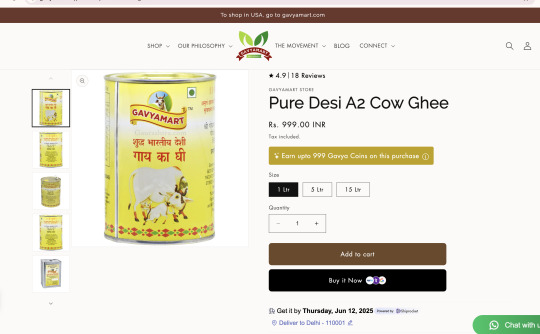
In a world where synthetic additives and fast foods dominate, there is a renewed interest in age-old Indian wisdom—particularly when it comes to nutrition and wellness. One product that has made a grand comeback, both in Indian kitchens and wellness circles, is Organic A2 Ghee. Not just a staple, it is a superfood, a cultural emblem, and a powerful healer all in one.
But what exactly is A2 Ghee? Why is it gaining popularity across India and globally? And what sets organic A2 ghee apart from regular clarified butter or ghee available in the market? Let’s delve deep into the golden world of Organic A2 Ghee in India.
What is A2 Ghee?
A2 Ghee is a clarified butter made from the milk of desi Indian cows such as Gir, Sahiwal, Red Sindhi, Tharparkar, and Rathi. These cows naturally produce A2 beta-casein protein, which is easier to digest and believed to be healthier compared to A1 protein, which is found in milk from most European breeds like Jersey and Holstein.
The traditional Bilona method is often used to prepare A2 Ghee. This two-step process involves:
Curdling the A2 milk to make curd,
Churning the curd to extract butter,
Heating the butter on a slow flame to produce golden, aromatic ghee.
This meticulous method retains essential nutrients, antioxidants, and the rich, nutty flavor that has made ghee a beloved ingredient in Indian cuisine.
The Difference Between Regular Ghee and Organic A2 Ghee
Not all ghee is created equal. Regular ghee often comes from milk of crossbred cows that produce A1 protein. Furthermore, the milk may be sourced from animals given hormones, antibiotics, or raised in cramped commercial dairies. Add to this chemical-based feed and mechanical ghee processing, and you have a product that’s far removed from what our ancestors used.
Organic A2 Ghee, on the other hand:
Comes from grass-fed Indian desi cows that produce only A2 milk
Is made using the Bilona process, not industrial methods
Is free from preservatives, chemicals, and synthetic flavoring
Is rich in Omega-3 fatty acids, Vitamin A, D, E, and K, and butyric acid
Tends to be more digestible, even for people with lactose sensitivity
Health Benefits of Organic A2 Ghee
Organic A2 Ghee is not just a cooking ingredient—it's a wellness tonic. Here's why Ayurveda and modern science both advocate its consumption:
1. Supports Digestion
The high content of butyric acid in A2 ghee improves gut health and helps reduce inflammation in the digestive tract. It promotes the growth of healthy gut bacteria, which is crucial for immunity and nutrient absorption.
2. Boosts Immunity
A2 ghee is a natural immunity booster. It contains fat-soluble vitamins (A, D, E, and K) that support immune function, bone strength, and hormonal balance.
3. Good for the Heart
When consumed in moderation, the healthy fats in A2 ghee help increase HDL (good cholesterol) and reduce LDL (bad cholesterol), supporting heart health.
4. Strengthens Bones and Joints
A2 ghee aids in calcium absorption and lubricates the joints. It is often recommended for people suffering from arthritis or joint pain.
5. Improves Skin and Hair Health
Consumed or applied topically, A2 ghee can nourish the skin, reduce dryness, and promote a healthy glow. It’s a favorite ingredient in many Ayurvedic skincare rituals.
6. Helps with Weight Management
Contrary to popular belief, the healthy fats in A2 ghee can actually aid in weight loss by improving metabolism and keeping you full for longer.
Why India Is Leading the Organic A2 Ghee Movement
India has always been the cradle of ghee-making traditions. But in recent years, there has been a conscious shift back to using pure, chemical-free, ethically-produced dairy products. Here’s why India is at the forefront of this movement:
Heritage Breeds: India has the largest population of desi cow breeds, which are naturally suited for producing A2 milk.
Ayurvedic Backing: Ghee has always been central to Ayurvedic medicine, used in cooking, therapies (like Panchakarma), and healing rituals.
Organic Farming Initiatives: With increasing government and private sector push toward organic farming, more Indian dairies are moving to sustainable, cruelty-free practices.
Consumer Awareness: Indian consumers are becoming more health-conscious and are actively seeking alternatives to processed foods.
How to Identify Authentic Organic A2 Ghee
With rising demand, the market is unfortunately flooded with products falsely claiming to be “A2” or “organic.” Here’s what to look for:
Source of Milk: Ensure it comes from indigenous Indian breeds (Gir, Sahiwal, etc.)
Preparation Method: Look for “Bilona Ghee” or mention of traditional curd-churning methods
Certification: Reputed organic certifications such as FSSAI Organic India, Jaivik Bharat, or USDA Organic
Transparency: Brands should disclose cow breed, farming practices, and processing methods
How to Use Organic A2 Ghee in Daily Life
The versatility of A2 ghee makes it a must-have in every Indian home:
Cooking Medium: Use it for sautéing, frying, or as a finishing drizzle over dals and khichdi.
Morning Ritual: A spoon of A2 ghee with warm water can detoxify the system.
In Coffee or Tea: Inspired by bulletproof coffee, add a teaspoon for a creamy, energy-boosting drink.
Skin and Hair Care: Massage it on dry skin or use as a natural hair conditioner.
The Future of Organic A2 Ghee in India
With growing awareness, the future looks golden for A2 ghee in India. Consumers are not just looking for food—they are looking for functional nutrition, sustainability, and transparency.
Many Indian startups and farms are stepping up to meet this demand. From small-batch ghee producers to organic cooperatives, the focus is shifting toward traceable, ethical, and Ayurvedic methods of ghee-making.
Additionally, A2 Ghee is making waves internationally. Wellness influencers and Ayurvedic practitioners across the globe are advocating for its use in everyday health routines.
Final Thoughts
Organic A2 Ghee is more than just a health trend—it is a return to our roots. Rich in nutrients, loaded with wellness benefits, and made with compassion for animals and nature, it embodies the best of traditional Indian wisdom and modern conscious living.
Whether you are health-conscious, spiritually inclined, or just someone who wants their food to be pure and nourishing, Organic A2 Ghee is a golden addition to your lifestyle.
Let’s bring back the purity of our grandmothers' kitchens and nourish our families with the golden goodness of Organic A2 Ghee—because true health begins with what’s on your plate.
0 notes